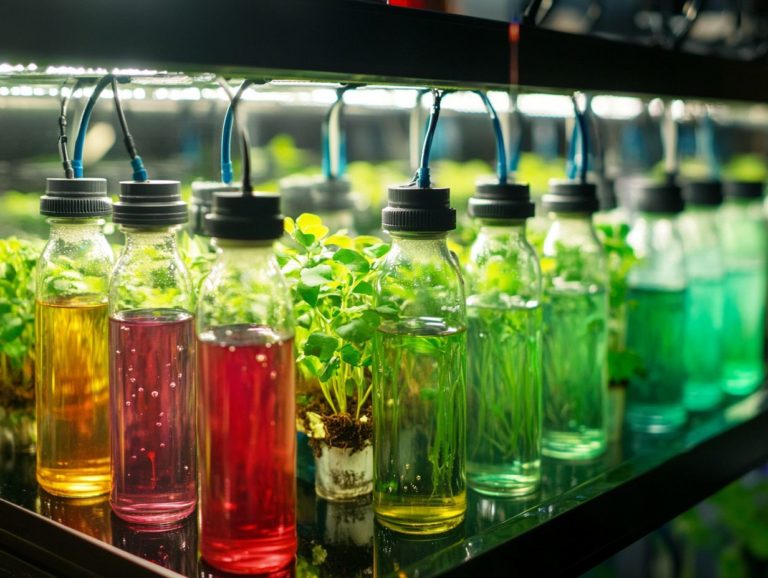The Importance of Calcium in Hydroponics
Calcium is essential for the health and growth of your plants, particularly in hydroponic systems. Nutrients are delivered straight to the roots, ensuring optimal plant nutrition.
By understanding its functions and benefits, you can optimize your plant development. This article delves into the symptoms of calcium deficiency, magnesium deficiency, effective methods for identification and treatment, and the best strategies for supplying calcium in a hydroponic setup.
Learn about the factors that influence calcium availability, such as pH levels and water quality, and tips to maximize calcium uptake, ensuring your plants thrive. Whether you re just starting out or you re a seasoned grower, gaining insight into calcium s role will elevate your hydroponic gardening experience.
Contents
- Key Takeaways:
- What is Hydroponics?
- The Role of Calcium in Plant Growth
- Symptoms of Calcium Deficiency in Plants
- Methods for Providing Calcium in Hydroponics
- Factors Affecting Calcium Availability in Hydroponics
- Maximizing Calcium Uptake in Plants
- Frequently Asked Questions
- What is the role of calcium in hydroponics?
- Why is calcium important for hydroponic plants?
- How does a lack of calcium affect hydroponic plants?
- What are some good sources of calcium for hydroponic systems?
- How much calcium should be added to a hydroponic nutrient solution?
- Can too much calcium be harmful for hydroponic plants?
Key Takeaways:

- Calcium plays a crucial role in plant growth and development in hydroponics. It helps with cell wall structure, enzyme activation, and nutrient uptake, which includes important nutrients like nitrogen, important nutrients, and potassium. Act now to ensure your plants thrive!
- Identifying and treating calcium deficiency in plants is essential for maintaining a healthy hydroponic system. Leaf symptoms, nutrient solution, and pH levels are some factors to consider.
- To maximize calcium uptake in plants, it is important to maintain proper pH levels, provide adequate nutrient solution and supplements, and follow tips for optimal absorption, considering factors such as the electrical conductivity of the water and nutrient interactions. This will lead to healthier and more productive plants in your hydroponic system.
What is Hydroponics?
Hydroponics is a groundbreaking agricultural approach that allows you to cultivate plants without soil, using nutrient solution that delivers essential elements directly to the roots. With various hydroponic systems at your fingertips, you can supercharge plant growth!
By controlling factors such as pH levels, the electrical conductivity of the water, and water quality, you ll find that hydroponics offers a more efficient alternative to traditional farming, ensuring your plants receive exactly the nutrient balance they need for robust growth.
Beyond enhancing yield and minimizing resource waste, hydroponics provides a variety of system options including deep water culture, nutrient film technique, and aeroponics each tailored for different environments and plant types. This flexibility allows you to customize your setup based on available space, budget, and specific crop needs.
The role of nutrient solution is vital, as they ensure a direct supply of macronutrients and micronutrients essential for optimal plant metabolism and growth.
As climate change and urbanization challenge conventional agriculture, embracing hydroponics emerges as a sustainable solution that not only conserves water but also enables food production in urban areas, ultimately bolstering global food security.
The Role of Calcium in Plant Growth
Calcium is critical for plant growth, acting as a key nutrient that underpins various physiological processes, such as cell division, cell wall integrity, and nutrient interactions. In hydroponic systems, maintaining optimal calcium levels is critical for achieving nutrient balance, which profoundly impacts overall plant health.
When plants receive the appropriate amount of calcium, they enhance their ability to absorb other nutrients, fostering vigorous growth and development. By grasping the significance of calcium and its multifaceted functions, you can fine-tune your nutrient management strategies, leading to healthier and more productive crops.
Now that you know the importance of calcium in hydroponics, start optimizing your setup today!
Functions and Benefits of Calcium
Calcium plays a key role in your plants’ nutrition. It stabilizes cell walls, activates enzymes, and helps with nutrient uptake, all crucial for promoting overall plant health.
It s essential for chlorophyll synthesis and photosynthesis, processes that are the backbone of plant growth.
When calcium levels are adequate, you’ll notice improved resistance against diseases and physiological disorders. This makes it a vital nutrient in hydroponic systems designed to maximize crop yields.
This essential nutrient supports the structural integrity of plant tissues. It also ensures that cell division and elongation occur seamlessly.
Calcium helps maintain a balanced pH in the soil, creating optimal conditions for beneficial microbial activity. This, in turn, enhances nutrient availability.
Calcium is integral in moderating various physiological processes, such as stomatal movement and transpiration. This improves water use efficiency.
Incorporating calcium into your nutrient management practices can significantly bolster your plants’ resilience against environmental stressors like drought or extreme temperatures. Don’t wait! Take action now to ensure your plants thrive by monitoring calcium levels effectively.
Symptoms of Calcium Deficiency in Plants

Calcium deficiency in plants can reveal itself through a range of symptoms that signal critical nutrient imbalances. These ultimately impact the health and productivity of your plants.
You may notice common signs such as blossom end rot in tomatoes or tip burn in hydroponic lettuce both of which clearly indicate insufficient calcium levels.
Recognizing these symptoms is crucial for you as a grower. Swift intervention can halt further disruption of nutrient uptake and promote optimal growth in your hydroponic systems.
By identifying these indicators early, you can make timely adjustments to your nutrient solution concentration, efficiently correcting any deficiencies.
Identifying and Treating Deficiency
Identifying and treating calcium deficiency in your plants requires meticulous nutrient monitoring and careful assessment of your nutrient solution.
Keep a keen eye out for specific symptoms, such as blossom end rot in tomatoes or tip burn in lettuce both indicating calcium levels are not up to par.
In addition to these visual cues, you must conduct regular pH tests. This is essential, as pH levels outside the optimal range can lead to nutrient lockout, making it hard for your plants to take in the nutrients they need.
To provide immediate relief to struggling plants, consider implementing foliar sprays enriched with calcium. This nutrient supports cell wall structure and plays a crucial role in regulating various physiological processes.
By addressing calcium deficiency promptly, you’re setting the stage for healthier plants and ultimately enhancing your overall yield!
Methods for Providing Calcium in Hydroponics
Achieving adequate calcium levels in hydroponics is meticulous but essential. This can be accomplished through various methods of nutrient solution preparation.
Incorporating calcium sources such as calcium sulfate, calcium nitrate, and calcium chloride into your nutrient solutions is key. These solutions maintain optimal calcium levels, ensuring that your plants can absorb this essential nutrient effectively.
By regularly fine-tuning your nutrient solution application according to the health and growth stages of your plants, you can significantly enhance nutrient availability and balance.
This, in turn, promotes robust crop yields. Understanding the nuances of preparing and applying these solutions is essential for a successful nutrient management program.
Nutrient Solutions and Supplements
Nutrient solutions and supplements are essential for ensuring your plants receive the calcium and other critical nutrients necessary for optimal nutrition in hydroponic systems. By carefully selecting the right nutrient solution stock, you can customize your calcium supplements and other nutrients to meet the specific needs of your plants.
This level of customization enables you to fine-tune nutrient mixes based on different plant species and adapt your solutions in response to environmental factors like light intensity and growth phases. Such a proactive strategy helps prevent nutrient deficiencies that could hinder both growth and yield.
By incorporating a variety of nutrient sources from organic inputs to synthetic blends you can achieve synergistic effects that optimize nutrient availability.
With advanced hydroponic systems at your disposal, you can closely monitor nutrient levels, making timely adjustments and ensuring your plants receive a balanced diet throughout their entire growth cycle.
Factors Affecting Calcium Availability in Hydroponics

Several factors significantly influence calcium availability in hydroponic systems. It’s crucial to monitor and manage them diligently. Key aspects like pH levels, water quality, and electrical conductivity play pivotal roles in determining nutrient balance and uptake.
Maintaining optimal pH levels ensures that calcium remains soluble and readily available for plant absorption. The quality of water also affects how nutrients interact within the solution. By understanding these factors, you can create a thriving environment for your plants.
pH Levels and Other Considerations
pH levels are one of the most important elements in hydroponics, directly influencing the balance of nutrients, including calcium. By keeping the right pH levels, you ensure that calcium remains soluble and ready for your plant roots. Improper levels can lead to nutrient lockout, which means plants cannot absorb the nutrients they need, affecting their growth.
The quality of your water is vital for maintaining these levels since contaminants can alter pH and disrupt nutrient interactions. Regular monitoring and adjustment of pH levels are essential for successful hydroponic growing.
Understanding that the optimal pH range typically falls between 5.5 and 6.5 can significantly impact your plants vitality and yield. Utilize pH testing kits or digital pH meters to accurately monitor these levels, allowing you to make necessary adjustments. If the pH strays outside the preferred range, use acidic or basic additives to bring it back in line.
Incorporating clean, filtered water into your nutrient solution helps maintain stable pH levels, ensuring that your plants effectively absorb vital elements. Prioritize pH management to foster robust growth and optimal health for your crops.
Maximizing Calcium Uptake in Plants
Maximizing calcium uptake in your plants is essential for robust growth and productivity. This requires a thoughtful approach to nutrient absorption within hydroponic systems.
Adjust your nutrient mix and environment to boost calcium availability for your plants. Simple tweaks can make a big difference! Factors like light intensity, temperature, and relative humidity are crucial in determining how effectively your plants absorb calcium.
By implementing best practices in nutrient management, you can achieve improved yields and enhance the overall health of your hydroponic garden.
Tips for Optimal Absorption
To achieve optimal calcium absorption in your hydroponic systems, maintain the right calcium levels. Regularly check your nutrient levels and prepare your nutrient solutions carefully.
Test calcium concentrations often. Adjust your nutrient recipe based on your plants’ growth stages and specific needs.
Using chelated forms of calcium greatly improves its availability, especially if pH levels are acidic. Acidic conditions can hinder calcium uptake.
Make sure there is enough water and oxygen in the root zone to maximize calcium absorption. By using these practical techniques, you can enhance your nutrient solutions and boost your plants vitality and yield potential!
Frequently Asked Questions

What is the role of calcium in hydroponics?
Calcium is vital for plant growth. It strengthens cell walls and aids in nutrient uptake.
Why is calcium important for hydroponic plants?
Calcium promotes strong and healthy plants. It supports root and shoot growth, nutrient transport, and enzyme activation.
How does a lack of calcium affect hydroponic plants?
A calcium deficiency can stunt growth and weaken stems. It may also cause discolored leaves and reduced yields.
What are some good sources of calcium for hydroponic systems?
Common sources include calcium nitrate, calcium chloride, and calcium carbonate.
How much calcium should be added to a hydroponic nutrient solution?
Add between 100-200 ppm (parts per million) of calcium to your nutrient solution.
Can too much calcium be harmful for hydroponic plants?
Yes, too much calcium can cause nutrient imbalances and lead to nutrient toxicity in plants.






